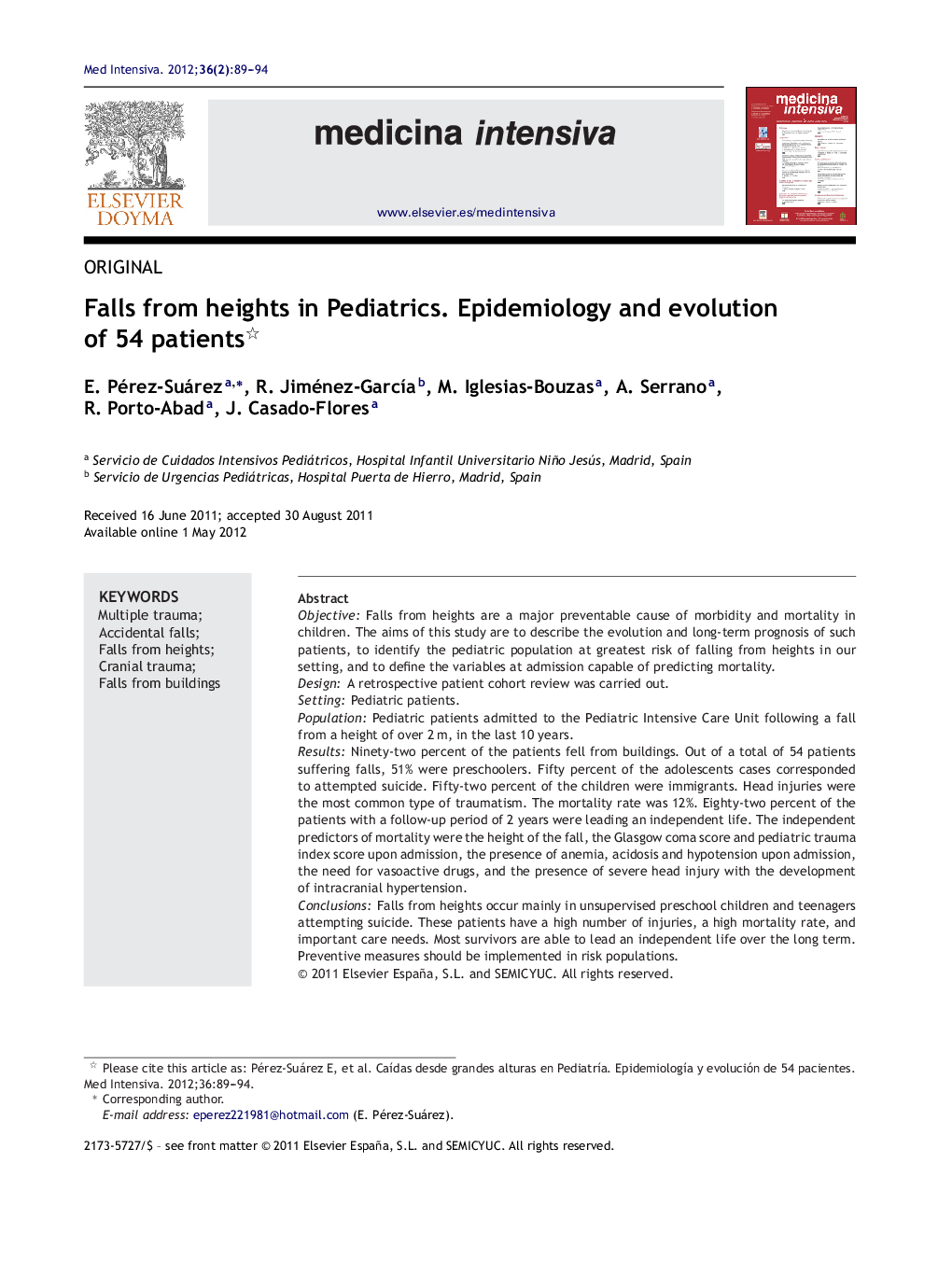| Article ID | Journal | Published Year | Pages | File Type |
|---|---|---|---|---|
| 3114343 | Medicina Intensiva (English Edition) | 2012 | 6 Pages |
ObjectiveFalls from heights are a major preventable cause of morbidity and mortality in children. The aims of this study are to describe the evolution and long-term prognosis of such patients, to identify the pediatric population at greatest risk of falling from heights in our setting, and to define the variables at admission capable of predicting mortality.DesignA retrospective patient cohort review was carried out.SettingPediatric patients.PopulationPediatric patients admitted to the Pediatric Intensive Care Unit following a fall from a height of over 2 m, in the last 10 years.ResultsNinety-two percent of the patients fell from buildings. Out of a total of 54 patients suffering falls, 51% were preschoolers. Fifty percent of the adolescents cases corresponded to attempted suicide. Fifty-two percent of the children were immigrants. Head injuries were the most common type of traumatism. The mortality rate was 12%. Eighty-two percent of the patients with a follow-up period of 2 years were leading an independent life. The independent predictors of mortality were the height of the fall, the Glasgow coma score and pediatric trauma index score upon admission, the presence of anemia, acidosis and hypotension upon admission, the need for vasoactive drugs, and the presence of severe head injury with the development of intracranial hypertension.ConclusionsFalls from heights occur mainly in unsupervised preschool children and teenagers attempting suicide. These patients have a high number of injuries, a high mortality rate, and important care needs. Most survivors are able to lead an independent life over the long term. Preventive measures should be implemented in risk populations.
ResumenObjetivoLas caídas desde altura son una importante causa de morbimortalidad prevenible en la edad pediátrica. Los objetivos de este estudio son describir la evolución y el pronóstico a largo plazo de los pacientes precipitados, identificar la población pediátrica con mayor riesgo de sufrir caídas desde altura en nuestro medio y definir las variables al ingreso asociadas a mortalidad.DiseñoEstudio de una cohortes retrospectivo.ÁmbitoPediatría.ParticipantesPacientes politraumatizados ingresados en el servicio de Unidad de Cuidados Intensivos Pediátricos tras haberse precipitado desde una altura superior a dos metros a lo largo de 10 años.ResultadosEl 92% de las caídas se produjeron desde edificios. De 54 pacientes precipitados, el 51% fueron preescolares. En adolescentes, el intento de suicidio ha sido la causa en la mitad de los casos. Un 52% pertenece a familias inmigrantes. El traumatismo craneoencefálico fue la lesión más frecuente. La mortalidad fue del 12%. De los pacientes en los que se realizó seguimiento a los dos años, el 82% llevaban una vida independiente sin secuelas. Los factores independientes asociados a mortalidad fueron: la altura de la caída, la puntuación en la Escala de Coma de Glasgow y en el Índice de Trauma Pediátrico, la anemia, la acidosis y la hipotensión al ingreso, la necesidad de drogas vasoactivas, y la presencia de TCE grave con desarrollo de hipertensión intracraneal.ConclusionesLas caídas desde grandes alturas se producen sobre todo en preescolares sin supervisión y en adolescentes por tentativa de suicidio. Estos pacientes presentan un gran número de lesiones, una alta mortalidad y altas necesidades asistenciales. La mayoría de los supervivientes llevan una vida independiente a largo plazo. Sería necesario implantar medidas preventivas, sobre todo en la población de riesgo.
